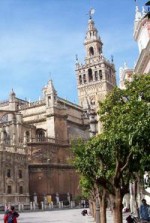Sojourn in Spain

After the Roma fortune teller traced a line across my forehead with her index fingernail, she pressed a sprig of rosemary into the palm of my hand and told me I should expect a phone call later that evening. Apparently, an old friend was going to invite me to dinner.
Then she stuck out her hand, and in an impatient fashion, said “pay me” in Spanish. I refused because she had said the rosemary was a gift, gratis, and hence only allowed her to harass me for the laudable aim of getting something for free.
Navigating through fortune tellers and the kitschy, wooden horse-drawn carriages – and what horses left behind – wasn’t too bad considering I had the choice of dealing with this minor inconvenience or not seeing Seville’s Cathedral, which is arguably the world’s oldest Gothic structure and, by some measurements, its biggest cathedral.
The Cathedral was well worth the visit, because it is home to both Christopher Columbus’ tomb and the Giralda, a bell tower that was once the minaret of a 12th century mosque. The Cathedral was built around it after the second Christian conquest of Spain.
What made the Giralda stand out from the many other towers I’d climbed was that the ascending passage was comprised of a ramp, not stairs.
The view from the top provides a panorama of Seville, as well as the opportunity to peer into keyhole-shaped alcoves along the route where some of the tower’s old iron bells have been preserved for viewing.
Literally a stone’s throw away from the cathedral is the Archivo General de Indias, the building in which documents pertaining to the Spanish colonies were kept. When I visited, the exhibition material was a little thin, possibly because the Archive was putting together an exhibit. Nevertheless, several groups of display panels displayed hand-drawn maps of some of the early explorers of South and Central Americas.
Sure, the quality of the maps was cartoonish at times, often without a geometric perspective. But it would have felt wrong to mock the flat rendition of volcanoes, the line portrayal of huts and the Godzilla-sized jungle felines as drafted in the eyes of the people who first saw these lands. If, like the first explorers, I didn’t know what extended beyond the margin of these maps, my depiction of the unknown would probably assume supernatural proportions.
Because Seville is located in Andalusia – Spain’s southernmost region – I’d hoped to get a real sense of authentic Andalusian cuisine.
Though it wasn’t the brightest idea to try gazpacho – a chilled tomato soup – in the dead of winter, I was disappointed that the gazpacho served in most eateries tasted like what I’d bought at the supermarket a week before.
Because Seville is far from Barcelona, my only viable transportation option was a plane. Although there are currently several low-cost carriers that operate in Spain, it’s still cheapest to keep travel dates a bit flexible, because weekend plane tickets with Friday departure and Sunday return are significantly more expensive. For that reason, I skipped school that Friday (getting my homework assignment beforehand, of course) and came back in the hours between Saturday night and Sunday morning – had I not done so, I would not have had the money to go.
Another money-saving tip I made use of was asking the ticket-counters at museums, cathedrals and monuments whether they offer student discounts. On several occasions, my USF student ID actually helped me to get into monuments at half the cost of regular admissions, or even for free. At times, the ticket vendor didn’t recognize USF (hey, it happens), as it happened to me at Seville’s Archeological Museum. But you can pass for a student if you look young and student-like.






